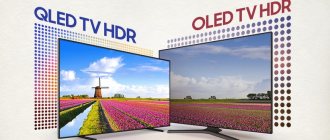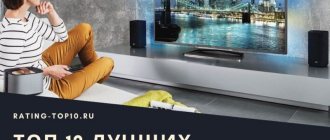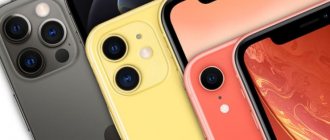Design
Externally, the devices do not copy each other.
Most often, the housing of inexpensive TVs is made of the usual black plastic. This rule is also true for the models we are considering. But not everyone! Leff and Philips will please you with white colors. Perhaps these TVs look best on or next to the refrigerator. Also, these devices will find a place in any other room, the interior of which is decorated in light colors.
| Name | Dimensions | Weight |
| Leff 24H111T | 553x335x72 mm | 3.1 kg |
| LG 24TN520S-PZ | 563x341x58 mm | 3.3 kg |
| Philips 24PFS5605 | 567x340x74 mm | 3.05 kg |
| Polarline 24PL51TC-SM | 551x336x64 mm | 2.6 kg |
| Samsung T24H395SIX | 547x335x49.3 mm | 4.2 kg |
However, the above-mentioned models are not the most beautiful. On the contrary, the budget TV distributed under the Leff brand seems somehow unsightly. And the cutest one is Polarline 24PL51TC-SM. This is due to the presence of a silver D-shaped stand. It also doesn't have the widest screen bezel. Approximately the same is used by a device from Samsung.
Ratings
Polarline: 4.6, Samsung: 4.5, LG: 4.4, Philips: 4.4, Leff: 4.3
Polarline 24PL51TC-SM
Stylish design
Instead of boring legs, it uses a silver D-shaped stand.
Display
The screen is the most important part of any TV
As you know, LG is one of the most widespread manufacturers of relatively small and inexpensive IPS panels. However, for some reason her TV received a WVA display. This makes the device not the best choice for placement in the kitchen. The fact is that such a screen is not capable of boasting maximum viewing angles. However, Samsung also did not want to achieve the ideal, limiting itself to a PLS matrix, which also suffers from mediocre color rendition. But the display of this TV has a high resolution. Therefore, the buyer will enjoy a detailed picture.
| Name | Permission | Matrix type | Frequency | Viewing Angles | Black depth |
| Leff 24H111T | 720p | V.A. | 60 Hz | — | + |
| LG 24TN520S-PZ | 720p | W.V.A. | 50 Hz | — | + |
| Philips 24PFS5605 | 1080p | V.A. | 50 Hz | — | + |
| Polarline 24PL51TC-SM | 720p | TN | 50 Hz | — | — |
| Samsung T24H395SIX | 1080p | PLS | 60 Hz | — | — |
Philips TV also boasts Full HD resolution. But its screen is created using a different technology, which is why it has very modest viewing angles. However, this also applies to Polarline with its TN display. If we talk about Leff 24H111T, then this is the most difficult case. Initially, the device was equipped with an IPS matrix. However, now on sale there are mainly copies with a screen made using one of the varieties of VA technology.
In a word, the screens of all the TVs we are considering are bad to one degree or another. But what else could you expect from a device whose display diagonal does not exceed 24 inches? And let's not forget that their manufacturers had to save a lot.
Ratings
Samsung: 4.3, Philips: 4.2, LG: 4.0, Leff: 3.8, Polarline: 3.7
Functions
We evaluate the capabilities of TVs
Surprisingly, even such small devices have recently begun to receive Smart TV support. But, of course, not all. Philips and Leff have only basic functionality. This means that they are able to record TV broadcasts onto a USB drive, as well as play back its contents. In this case, particularly heavy files may not run - especially on Leff, which is intended mainly for viewing HD content.
As for the other three TVs, Smart TV is fully implemented on them. But Polarline will be annoying at times even if it is placed somewhere in the kitchen. The fact is that this model has Android at its disposal. And let's remember that it belongs to the budget segment. Need I say that there was no room under the case for a particularly powerful processor? As a result, the buyer will regularly experience slowdowns.
It’s easy to guess that the best implementation of Smart TV is from Samsung and LG. Comparing these two models does not reveal a winner - the speed of both operating systems is approximately the same, which makes the price-quality ratio almost ideal. We also note good interaction with a smartphone, from which you can display videos or photos on the TV without any problems.
Ratings
LG: 4.5, Samsung: 4.5, Polarline: 4.3, Philips: 4.0, Leff: 3.9
LG 24TN520S-PZ
Smart functionality
The TV has a stable working WebOS, thanks to which access to most online cinemas is provided. A good plus for the price-quality ratio.
How to choose a TV
It is quite difficult to classify televisions in detail - such a variety of types are presented on the market. In short, before purchasing you will need to decide on a number of questions:
1. Budget and willingness to pay for some additional functions.
2. Installation location of the panel - the resolution and diagonal of the screen, as well as its type, depend on this.
3. Source of content (terrestrial, cable or satellite television, Internet, external media).
Diagonal and screen resolution
The diagonal of a television panel and the optimal resolution are not only related to each other, but also depend on the distance of the screen from the viewer. So choosing the size of a TV and the number of pixels is a complex issue.
Selecting the diagonal
To determine the optimal screen diagonal, it is recommended to divide the distance to it by 3, converting all units of measurement to centimeters. For example, if the chair is located 2 measures from the panel installation location, the size of the TV should be:
200 cm ÷ 3 = 67 cm (26 inches).
But here it is not necessary to adhere to strict calculations: 3-5 inches upward or downward are quite acceptable. And, of course, no one will prevent you from choosing a larger screen than required. The main thing is that the entire picture can be taken in at one glance, and not run over it with your eyes.
Optimal screen sizes with reasonable tolerances are shown in the table:
| Distance to TV | Diagonal |
| up to 1.8 m | 17″ — 27″ |
| 1.8 - 2.6 m | 27″ — 40″ |
| 2.6 - 3.1 m | 40″ — 47″ |
| 3.1 - 3.6 m | 47″ — 56″ |
| from 3.6 m | from 56″ |
Which resolution should I choose?
The entire TV screen consists of tiny dots called pixels. Together they merge into a single picture. The more pixels in the matrix, the better and clearer the image. But from a great distance it will no longer be possible to assess this - so is it worth overpaying?
HD quality is considered minimally acceptable by today's standards, although it is already becoming obsolete. Nowadays, the two most relevant resolution options for TVs are Full HD and UltraHD 4K. There is also ultra-high quality 8K, but for now this is too far into the future.
According to statistics, among sold large-diagonal TVs (from 60″), 4K models account for 95%. And although overall equipment sales have fallen due to the coronavirus pandemic, this ratio has not changed significantly. Of course, we are talking about the TOP segment, but the demand for UltraHD will only grow.
The reason is that the amount of ultra-high definition video content is increasing, and 4K TVs themselves are becoming more affordable.
The leader in the production and sales of UHD panels is the South Korean brand Samsung, followed by LG. These same companies are actively introducing 8K technology.
UltraHD TVs definitely outperform others in image quality and clarity. But that doesn't mean you need a 4K panel. If the distance to the screen is too far, you will not see the difference from Full HD. Then, within your budget, you can purchase a panel with a lower resolution and richer functionality. Or just save a considerable amount.
The diagram below will help you make your choice. It shows what resolution a person with normal vision can perceive, taking into account the size of the screen and its distance.
In the diagram, select the distance to the TV on the vertical axis, and the calculated diagonal on the horizontal axis. If the intersection point of these coordinates is above the blue line, Full HD will be enough for you. If it’s at or below it, it’s definitely worth purchasing a 4K panel.
An Ultra HD TV will also be needed if it is purchased to connect to a game console.
Remote control
How convenient is the control?
Of course, such inexpensive TVs could not have a remote control that works via Bluetooth. This means that you shouldn’t rely on voice commands, as well as using the accessory as a pointer. In the box with each of the models we are considering there is a familiar remote control that sends commands via an infrared port. The sizes of all remote controls, if they differ, are not too much.
If you compare accessories, it is difficult to identify a winner. Perhaps the best remote control was created by the owners of the Philips brand. Its buttons are easy to press blindly. I’m glad that they moved to the lower part of the accessory with the numbers, which are now used quite rarely. Some dissatisfaction may be caused only by the slightly increased width of the remote control.
If we talk about outsiders, then they can be called accessories supplied with TVs from Samsung and LG. Yes, they turned out to be quite miniature. And LG even has an additional button to launch the IVI online cinema (it cannot be reconfigured). But the layout of the buttons turned out to be too crowded. As a result, it is impossible to press them blindly.
It should be noted that the LG 24TN520S-PZ supports the Magic Remote. However, purchasing it will not make voice control available. Apparently, inside the budget TV there is such a weak processor that it did not allow such a simple function to be implemented.
Ratings
Philips: 4.6, Leff: 4.5, Polarline: 4.5, Samsung: 4.3, LG: 4.2
Philips 24PFS5605
A high resolution
This TV boasts Full HD resolution.
Sound
What kind of built-in speaker system do the models have?
If the screen of a device does not exceed 24 inches, then it is foolish to expect perfect sound from it. None of the TVs we selected can boast of gorgeous bass and well-perceived volume. LG and Samsung are leaders in this regard - they include at least 10-watt acoustics. With it, there are no thoughts about connecting speakers or a small soundbar.
| Name | Number of speakers | Power | Low Frequencies |
| Leff 24H111T | 2 | 6 W | — |
| LG 24TN520S-PZ | 2 | 10 W | — |
| Philips 24PFS5605 | 2 | 6 W | — |
| Polarline 24PL51TC-SM | 2 | 6 W | — |
| Samsung T24H395SIX | 2 | 10 W | — |
Alas, Philips and two other Chinese TVs sound worse. The total power of their stereo speakers does not exceed 6 W. This is only enough in the kitchen. If the device is in a larger room, you will have to regularly turn the volume up to values close to maximum.
Ratings
LG: 4.6, Samsung: 4.6, Leff: 4.3, Philips: 4.3, Polarline: 4.3
Samsung T24H395SIX
Loud noise
The power of the acoustics used here has been increased to 10 W.
Philips or Samsung TV - which is better?
The development of technological progress very quickly brings innovations to the modern market. When purchasing a new model of TV equipment, it would not hurt to understand the functional capabilities of this equipment in advance, pay special attention to the features of different manufacturers, decide on an acceptable price, the size of the device and listen to the opinions of experts. In this article we will look at Philips, LGi or Samsung TV - which is better. To do this, we will perform a detailed analysis of companies and their products according to the most important characteristics.
How to choose a TV?
To correctly purchase a television device, you must adhere to some recommendations:
- When choosing the screen size, you need to take into account the dimensions of the room in which the TV device will be located. There is unspoken advice - that the distance to the monitor be equal to three screen diagonal sizes.
- It is necessary to accurately determine the technology for the production of television equipment, since each type has both positive and negative sides. Today, liquid crystal technology is the most widespread and in demand.
- For convenient viewing, you need to select the correct screen resolution.
- You need to decide on a brand. This choice is most often determined by personal preferences for the country of manufacture, the brand model, and sometimes even the design. For some, this preference does not make common sense. However, the question, “Philips” or “Samsung” TV - which is better, arises quite often.
- It is necessary to choose a brick-and-mortar store because a TV that meets your requirements should definitely be inspected before purchasing. Choosing an online store is not the best option.
- You need to look at the picture correctly. When choosing a TV device, you need to ask the store consultant for the remote control. All models in stores on demonstration stands are configured in such a way as to create an improved picture. The picture needs to be viewed in factory settings to really understand the functionality of the proposed model.
- You need to be able to listen to sound correctly. A television device means not only viewing a screen image, but also listening to audio messages. The bass sound should be low, even a little rumbling. Even at full volume and the maximum bass point, no rattling should be felt.
- It is necessary to correctly perceive information from store consultants. In addition to customizing the image on the demo stand, sellers throw out a lot of information consisting of a waterfall of incomprehensible terms and numerical parameters. Even for branded manufacturers, the declared parameters are relative, since there are a lot of methods that measure contrast, brightness and other indicators.
Which TV to choose and which is better - Samsung or Philips?
To decide which TV is better - Samsung or Philips, you need to consider the positive and negative characteristics of each brand.
Important! The digital technology market today represents many worthy brands. Our separate review will help you figure out “Which TV is better - Samsung or Sony?”
Fast scene smoothing
Since 2013, Samsung TV devices have the same 100 HZ fast scene smoothing feature as Philips TV equipment. This means that a similar indicator is characteristic of both brands.
But there is still a slight difference. Samsung TV LCDs use a faster response rate.
Important! If we conduct a comparative analysis of the quality and clarity of fast picture playback, the Samsung device for watching television shows wins in the budget range.
Important! If you are planning to place your TV on the wall, find out which TV bracket is best on our useful tips portal.
Playing media files from USB drives:
- Reading movies from USB hard drives and flash drives does not cause any problems with the Korean model of the Samsung television device. Any budget model is characterized by supporting any format and reading movies from USB drives.
- The Philips TV viewing device does not support many video formats.
Important! Does your TV not support Smart TV? Do not despair! Even on slightly outdated TV models you can use this functionality. We have prepared a separate article “How to choose a Smart TV set-top box for your TV?”
Tuners
The presence of built-in tuners in budget models of the two brands does not cause any differences. All models of LCD TVs have the following tuner devices: analog, DVB-C, DVB-T(2).
Important! There is no difference in the quality of analog signal processing; if you look at it, “Philips” or “Samsung” - which is better? Follow the link and find out in our special post “Digital tuner for TV - what is it?”
LCD matrices
The liquid crystal matrix used serves as a fundamental component, which determines 70 percent of the price factor. It is this matrix that plays a significant role for:
- picture reproduction quality;
- static contrast;
- color rendering and viewing angles.
Based on this criterion, you can decide whether “Philips” or “Samsung” is better:
- A Samsung television device uses S-PVA matrices, which are manufactured by the company itself. Such matrices are characterized by good brightness and high static contrast. Color rendition is not entirely natural, but quite decent for budget TV models. The S-PVA LCD matrix is characterized by the presence of deep black color and low response.
- Philips television devices use matrices from LG. Types of S-IPS matrices used. These types have lower contrast and are not as good at reproducing fast pictures, but the color rendition is more natural.
Important! Are you planning to add satellite TV to your new TV? We have collected all the useful information in the post “Which dish to choose for your TV?”
Design:
- Samsung TVs are distinguished by their elegant, sophisticated design. Budget models have a thickness not exceeding 4.6 cm.
- Budget television devices from Philips are characterized by the presence of thicker models.
Important! Each person has their own preferences. For some people, Philips television devices are attractive in design, while other users prefer the interesting design of Samsung.
Advantages and disadvantages
Let's look at the positive and negative aspects of television devices from two brands to understand which TV is better - Samsung or Philips.
Advantages of budget models from Samsung:
- The devices have a lower cost compared to Philips equipment.
- The ability to support various formats and high-quality playback of films from a hard drive and flash drive.
- The presence of a high degree of contrast and excellent brightness of the LCD matrix.
Advantages and disadvantages of Philips models:
- High-quality color rendition.
- It is not able to support all types of formats, and for some films there is no readability at all.
- Slow response of the main menu to requested functions.
Important! When purchasing new equipment for your home, be sure to take care of high-quality components. On our portal there is a separate article about one such component for a TV, “Coaxial cable for a TV - which one to choose?”
Mid-price range and higher-end models
Branded television devices from Philips and Samsung demonstrate more functional Smart TV and 3D models that have a stylish and sophisticated design. The S-IPS matrix from LG serves as a fundamental element for the model range up to the 7th edition of Philips. Samsung uses S-PVA matrices, which are its own developments.
Important! If you try to conduct a comparative analysis of image quality between television devices from leading companies, it is definitely difficult to determine the superiority of one model over another.
Each branded model has some disadvantages. For example, Philips television devices, even models with 400 Hz PMR functionality, while trying to reproduce fast pictures, are not able to achieve the required degree of clarity and sharpness of the moving image. The reason for this shortcoming, most likely, lies in the characteristic feature of the IPS matrix, which is characterized by a high response (6-8 ms), poor quality display of fast scenes and a static contrast in the range of 200:1.
Smart TV
Which TV is better - Samsung or Philips? Samsung supplies the modern market with optimal solutions from the best smart TV designs. This option is characterized by:
- convenient menu;
- the presence of a full-fledged browser;
- the ability to connect wireless elements such as a mouse and keyboard.
Important! Smart TV Samsung is a very fast menu response, the ability to download and install various applications and everyone’s favorite games for free. All applications are characterized by the presence of a Russian version, since they are mainly developed for the CIS market.
The Samsung Smart TV model is to some extent reminiscent of a computer, unlike the Philips Smart TV model, which has many problematic issues:
- Not every Smart TV model from Philips is equipped with a full-fledged service. For example, the PFL 3507 model is characterized only by the ability to access the YouTube service, in which you can only watch streaming videos.
- A similar model Samsung EH5300 – Smart TV has all the necessary possible functions.
Important! The Smart TV model from Philips has a much smaller number of different service programs for watching videos online. Additionally, there are no additional app options. Therefore, in this parameter, Samsung clearly has a clear advantage.
3D functional feature
Samsung TVs use active 3D technology. Philips also has active 3D in the PFL5 version, and the polarization type of passive 3D is used in the PFL6 version.
When comparing active 3D from Philips and Samsung, there is no significant difference in quality. For two branded models, the same conditions apply to create a 3D image. But since Samsung television devices have higher brightness parameters, viewing a 3D image is accompanied by an imperceptible deviation in brightness and contrast.
Important! If we consider the models of the Dutch company Philips, we can highlight a positive point - the ability to choose various 3D technologies. In addition, the PFL6 series of television devices use the Ambilight technological process. Modern technological process, depending on color reproduction, allows the TV device to be illuminated on both sides with LED elements, which contributes to the visual impact of the 3D picture.
All Samsung models from 40 inches are equipped with 3D glasses. For some branded 32-inch models, this equipment is also available. Philips TV devices come with 3D glasses only from version 6.
Tuners
For the Philips model range, only digital and analogue devices are used. Such tuners come in two varieties: terrestrial and cable. For Samsung TV, starting with the ES6307 model range, there are modern satellite tuner devices.
Advantages and disadvantages
Summarizing the above parameters, we list the advantages and disadvantages of each brand model in order to understand which TV is better - Samsung or Philips.
Pros and cons of Samsung TV:
- the presence of cheap 3D glasses;
- availability of modern satellite tuners;
- functional and convenient Smart TV option.
Advantages and disadvantages of Philips TV:
- active model technology uses expensive 3D glasses;
- availability of limited Smart TV capabilities;
- The model range allows you to select both active and passive 3D;
- application of Ambilight super technology.
Why LED TVs?
When choosing a modern TV device, users want not only to purchase multifunctional modern equipment, but also to buy reliable, high-quality equipment, which is characterized by a reputable manufacturer. In today's market, the most popular and in demand are LED TVs from LG, Samsung and Philips.
Such companies are characterized not only by the quality of their products, but also by the use of the latest technologies. Let's try to figure out why LED TVs are chosen the most.
Advantages of LED TV:
- Presence of high definition and detail reproduction. There is no blurring on the monitor of such a TV device, and the image has good sharpness.
- LED TVs are environmentally friendly, since LED backlighting does not use mercury.
- The LED TV category is characterized by a thin body and elegant design. The production features of this technology contribute to the presence of a relatively thin body.
- Very low electrical energy consumption. Particularly notable for the presence of such quality is TV equipment with the presence of side lighting.
Comparison of LG, Samsung and Philips TVs
To objectively evaluate LED TVs, we will consider one model from each manufacturer in one price segment. Let's conduct a comparative analysis:
- Samsung UE46F5020 at 46″;
- LG 47LA620V at 47″;
- Philips 46PFL4208T at 46″.
This will help you understand which TV is better - Samsung, LG or Philips
Screen format:
- For all branded models, the screen format is the same and is 16:9.
- The resolution is the same and equals 1920×1080.
Important! None of the manufacturers stands out in this regard. But for LG TV devices, a distinctive characteristic feature is the possibility of the presence of a polarizing passive 3D format. For this price range, this criterion is very significant.
Refresh rate setting
This criterion is important for any TV device, despite other functionality. Samsung television equipment is much inferior in this indicator to other branded models.
The refresh rate for Samsung branded TVs is 100Hz, while the other two models operate at 200Hz.
Important! Television devices from Philips and LG have a clearer picture.
Resolution
This indicator is not so important, but can become a priority when choosing a branded model. If we consider the amount of support for formats for connecting to a computer device, then:
- The Philips 46PFL4208T TV is much better with support for possible formats: 1920×1080, 1360×768, 1024×768, 640×480, 800×600;
- This series is completed by the Samsung UE46F5020 TV device, which has only two possible formats: 1920×1080, 640×480.
Interface
Currently, one of the decisive factors in purchasing TV devices is the number of interfaces. The right choice allows you to make the most of the functionality of the purchased equipment.
Important! The undisputed leader is the Philips model 46PFL4208T, which has the following ports and connectors:
- AV;
- SCART;
- Two USB types;
- Ethernet;
- Two types of audio input;
- Component portal;
- Three types of HDMI connectors;
- D-Sub.
The LG brand model is equipped with three USB connectors and four HDMI connectors. But the total number is still less than that of the Philips model.
Sound:
- Among the TV devices under review, the LG 47LA620 is the best model with 24 W audio power.
- Other branded models have a rating that is only 20 W.
Functional abilities
Which TV is better - Samsung, LG or Philips?
- When considering the functionality, Samsung equipment does not have the ability to support Wi-Fi wireless communications and the Smart TV format. In this regard, Samsung television devices are much inferior to other brand companies under consideration.
- Comparing the technical parameters of these models, there is a noticeable lag behind Samsung devices.
The lack of functionality to support the Smart TV function played a fundamental role in the decisive moment. The leader is the branded model LG 47LA620V, which is capable of supporting the 3D format, which at this stage is extremely important and relevant. Philips remains only second in this ranking.
Statistics
Statistics from reputable online publications published on public websites report that user reviews:
- more people trust Samsung television equipment, which is 26%;
- then to LG manufacturers, who have only 19%.
Video material
Therefore, when choosing a television device, you need to carefully study the technical parameters and read the reviews of competent people to prevent possible errors. And now you know how to deal with this and which is better - Philips or Samsung.
Share on social media networks:
Interfaces
Studying connectors and wireless modules
Usually such small TVs are not connected to an abundance of all kinds of equipment. Most often, the buyer is only able to connect a single smart set-top box or game console. It is not surprising that the manufacturers of the TVs we selected did not introduce a huge number of connectors.
Leff performed the worst in this regard. On its rear panel you can find one HDMI and one USB. However, for many buyers, oddly enough, this will be enough. Problems can only arise if the device is used as a monitor, and at the same time you will also need to connect a smart set-top box to it. Polarline also received one HDMI input. Other TVs have two such sockets.
| Name | HDMI | USB | Audio | Wireless |
| Leff 24H111T | 1 PC. | 1 PC. | Coaxial | — |
| LG 24TN520S-PZ | 2 pcs. | 1 PC. | Optic | Bluetooth, Wi-Fi 802.11n |
| Philips 24PFS5605 | 2 pcs. | 1 PC. | 3.5 mm optical | — |
| Polarline 24PL51TC-SM | 1 PC. | 2 pcs. | 3.5 mm coaxial | WiFi 802.11n |
| Samsung T24H395SIX | 2 pcs. | 1 PC. | 3.5 mm optical | WiFi 802.11n |
If you want to output sound to headphones, then know that many inexpensive TVs included in this comparison do not provide this option. Fortunately, not all. LG 24TN520S-PZ allows you to connect a wireless headset. And Philips, Samsung and Polarline received a 3.5 mm audio jack.
As you already know, a couple of TVs do not have Smart TV. This means that they do not need wireless modules. As for the other devices, all three have Wi-Fi, while only LG received the blue tooth. And it works in a reduced mode - you most likely won’t be able to connect anything other than headphones and a branded remote control.
Ratings
LG: 4.5, Philips: 4.4, Polarline: 4.4, Samsung: 4.4, Leff: 4.2
LG or Philips TV - which is better? Comparison
In the digital and household appliances market, TVs occupy one of the key positions in terms of sales volume. There are a lot of brands, and everyone strives to satisfy consumer needs. Accordingly, there are also many models offered.
We compare the most popular brands and models, and now we have LG and Philips TVs in our field of view. Which company will offer the best products?
To compare brands, we used 2 TVs from the same price category and similar parameters: Philips 40PFL5007K and LG 42LS560T model.
TV Philips 40PFL5007K
Philips 40PFL5007K
The most important advantage of the model is its ideal price-quality ratio. The model is really worth the money. This means that it does not have unnecessary functionality that is almost never used. Connoisseurs of minimalism will definitely appreciate the design - it is chic and made in the best traditions of this style.
The image on the screen deserves special attention - it is soft. The reason for the “softness” of the picture is Pixel Plus HD technology, which comes in handy here. Paired with the PMR function and a dynamic contrast ratio of 500,000:1, the picture is truly beautiful, but to see all the benefits of the technology, you need to output high-definition video content.
The TV is controlled by a remote control, which, thanks to Philips Easylink technology, is universal. The user will be able to control a Blu-Ray or DVD player, set-top box or cinema. This is actually a great technology that eliminates the need to use many remotes. The case has as many as 4 HDMI inputs and 3 USB ports, but the Wi-Fi module deserves special attention. Thanks to this module, Smart TV comes to life and the use of wires is eliminated.
And just like that, we quietly approached Smart TV Plus technology. The user receives enormous opportunities and access to any content, social networks and Internet resources. There is also a DVB tuner that allows you to watch satellite, digital or analogue television. But watching analog TV on such a TV is simply a crime.
The screen diagonal is 40 inches, dimensions are 929x600x240 mm with a weight of 15 kg. The model is quite easy to install due to its light weight. Philips 40PFL5007K is a TV without frills and bells and whistles, the absence of which makes it accessible to a wide range of consumers. The model is chic, but it can compete with models from other brands, namely LG.
LG 42LS560T review
model LG 42LS560T
The advantage of this TV over the one discussed above is its diagonal of 42 inches, which is slightly larger. The best resolution - FullHD is ideal for watching movies in excellent quality and is generally not suitable for analog television. Ease of operation is also a positive quality, but Philips is not inferior in this parameter either.
The disadvantage of this TV is the lack of a Smart TV function, but the manufacturer assures that this decision was made deliberately. Smart Energy is a good technology - thanks to it, the image adapts to the current lighting in the room. Color gamuts are also adjusted by 24p Real Cinema and Picture Wizard services. The manufacturer also took care of saving energy, but this cannot be called a strong advantage.
Weight 15 kg, dimensions 979x660x269 mm - these are the dimensions of the device, not much different from the Philips model. In general, there are no obvious advantages over the Philips TV. Rather, the disadvantage is the lack of Smart TV Plus technology.
Between TVs of the same price category from Philips and LG, the first brand has an obvious advantage.
Please rate the article:
Price
All TVs are sold at an adequate price.
Due to the dominance of Chinese manufacturers, there is now no point in selling a 24-inch TV at any high price. However, one cannot help but notice that Samsung and LG continue to mark up prices in order to make at least some noticeable profit. And this despite the fact that one of them offers the buyer a device with a screen whose resolution is 1366x768 pixels!
| Name | average price |
| Leff 24H111T | 9,500 rub. |
| LG 24TN520S-PZ | RUB 16,590 |
| Philips 24PFS5605 | RUB 14,990 |
| Polarline 24PL51TC-SM | 10,900 rub. |
| Samsung T24H395SIX | RUB 17,390 |
Philips also has a very high cost. This is due to a good set of connectors and a very high resolution display. But let's not forget that for this money you will get a model with no Smart TV, not to mention modest acoustics. In this regard, it cannot be said that such a TV has an ideal price-quality ratio. As for the other two devices, they received a mediocre display for a reason. It was he who allowed manufacturers to save money by achieving a very low cost. But this is a case where you need to think ten times about whether you should pay a little extra to get a better TV.
Ratings
Leff: 4.8, Polarline: 4.7, Philips: 4.5, LG: 4.4, Samsung: 4.4
Leff 24H111T
The most inexpensive
For this truly budget TV they ask for very little money.
Philips TVs reviews
See all prices
Philips TV 40PFL8605H customer reviews
Danil Kh.★★★★★ Advantages:
Cool design, gorgeous picture, convenient and intuitive menu, automatically sorts TV channels (first on first, NTV on fourth, etc.).
There is a built-in media player that reads not only standard extensions, but also ISO disk images, and also makes it possible to watch movies over a home network (to do this, you need to install and run Media Server on your computer, which you can download here: https://www.homemediaserver .ru/page10.php). 3D works great, before purchasing I heard that 40 inches is not enough for 3D - complete nonsense, absolutely normal. Disadvantages:
1. The place where the film was stopped is not remembered - for me an important drawback. 2.
The built-in media player has very slow rewinding (and not only when rewinding “heavy” films, as written in another review, but also on standard DVD rips too).3. HD movies with a high bitrate over the network are slow, despite the fact that I have a gigabit LAN. I don’t consider fingerprints on the screen a drawback - they installed it, connected all the cables, wiped it and that’s it. Why touch him every day? And if you need to turn it, you can use the edges. Comment:
The TV is very good, I definitely recommend it.
Along with it, I ordered Philips 3D glasses (2 pairs included with the transmitter) and an HDMI cable version 1.4 (versions 1.3 and lower are not suitable for 3D). On the very first day I watched “Avatar” in a horizontal stereo pair (in the TV menu you need to enable the appropriate 3D mode; on the computer the film was played with a classic media player with the K-Lite codec). Excellent device. Roman K. ★★★★ Advantages:
1) The quality of the picture on digital is solid 5. A sufficient number of settings to customize the picture to suit you. 2) Protective glass on the screen.
I really appreciated it when I installed the TV...3) Design. It is.4) Iron remote control. The buttons take some getting used to, but the remote itself is solid. You hold the thing in your hands...5) A good, clear menu. The instructions were only needed once, when sorting channels. Disadvantages:
1) SOUND.
Maybe, of course, there are fans of the sound like from a barrel, but obviously not me... The low frequencies are disgusting. There aren’t really any average ones, high normal ones can live. There is always an echo-like effect, I would call it a Chinese knockoff of Dolby surround. I turned off surround in the TV settings, but the effect did not disappear. Of course, you can listen to the news, but you can’t watch movies with such sound. External sound is a must. I understand perfectly well that it is impossible to realize normal sound in such a thin case, but then don’t write about how wonderful the sound is. 2) Channels could switch faster when switching by channel number. When switching by shifting left or right, the speed is normal. 3) Reception of analogue broadcasting. I thought for a long time whether to write about shortcomings or not. I decided that after all, yes. The TV found 43 channels. Old Phillips found 41. But it’s hard to look closer than 2.5 - 3 meters. On some channels the image is unclear, in others it ripples slightly. My eyes get tired. From 4 meters away, most channels look very good. I'm thinking about digital broadcasting... Comment:
The impressions from the TV are twofold. At first, there was a slight annoyance from watching analog broadcasting. The sound was frankly disheartening, but to be honest, I was ready for the picture from analog broadcasting. BUT when I turned on the movie “Avatar” in 1080 quality. Ooooooo... I looked spellbound, the colors were clear, the dynamics of the scenes. This is incomparable, naturally the external sound is 5.1. The summary is this. External sound, digital broadcasting, watching movies from external devices and you will be delighted and greatly impressed by this TV. If you take it to watch analogue broadcasts, it’s not worth it. ,
Philips TV 46PFL8605H customer reviews
Irina R.★★★★★ Advantages:
1. The image of high quality movies via an external USB drive is excellent, nothing slows down.2.
The Ambilight backlight is super, you won’t be able to watch TV without it because something is immediately missing. Power and brightness are adjustable. There are also three backlight options when the TV is turned off.3. The instructions are built into the TV, if you forgot something or need to find out how to do this or that operation, then you don’t have to look everywhere and remember where you put these damn instructions :-)4. The front panel is made of glass, which protects the screen itself.5. A universal stand, you can put it on a table (stand), or hang the TV on the wall, without additional mounting. (Hanging on my wall)6. The remote control is cool and not ordinary.7. Updatable software8. And quite a few important connectors, such as USB, Internet, HDMI, VGA. Disadvantages:
Everything related to watching movies via USB TV: 1.
This model does not support DTS sound (neither in software nor in hardware), it refuses to play movies with this codec via USB and says “the file is not readable or not found.” You have to search for movies in ACC and AC3.2. Rarely, but sometimes it refuses to play further after a pause or the image begins to log. But with rewinding it’s worse, almost always when you try to rewind, it jams and can only be treated by turning off and on the TV, so I try not to rewind anymore. Comment:
I am very pleased with the TV. When the TV is turned off, the glass panel in artificial light is like a mirror.
For me, as a girl, this is even + without having a large mirror in the room :-). When purchasing there was a problem with HD scaling, it stretched the image, removing two black bars at the top and bottom and everything turned out elongated, but in the latest firmware this was fixed, now everything is ok. The broadcast doesn’t show very well :-(, but this is the antenna I have, the TV is here nothing to do with it. PS I wrote to technical support about the DTS codec, they told me that it does not support it and the new firmware will not help, + they sent a table of supported formats, it may be useful to someone: https://s011.radikal.ru/i316/ 1011/b9/13a5dcf5d8c9.jpglogser★★★★★ Advantages:
Modern, stylish, good assembly, the backlight is pleasing. The delivery transforms into a wall bracket, do not buy separately.
Disadvantages:
Minus is a weak built-in media player, you need to buy another one and possibly glass protection on the screen, but this is if the TV is placed opposite the window and in case of complete discomfort it is solved by applying a matte film, for me this is more of a plus since it provides protection from a child’s encroachments on the screen.
Comment:
Why have prices dropped sharply on them!? per week for 13-15 tr. in online stores. It was 65-68 and now it’s 51-53, which is what I bought for 53 rubles. Satisfied. For everyone who will buy, do not buy the wall bracket separately, the stand transforms into a horizontal one and looks very stylish (while maintaining the required distance from the wall for lighting)
Photo © Shutterstock










